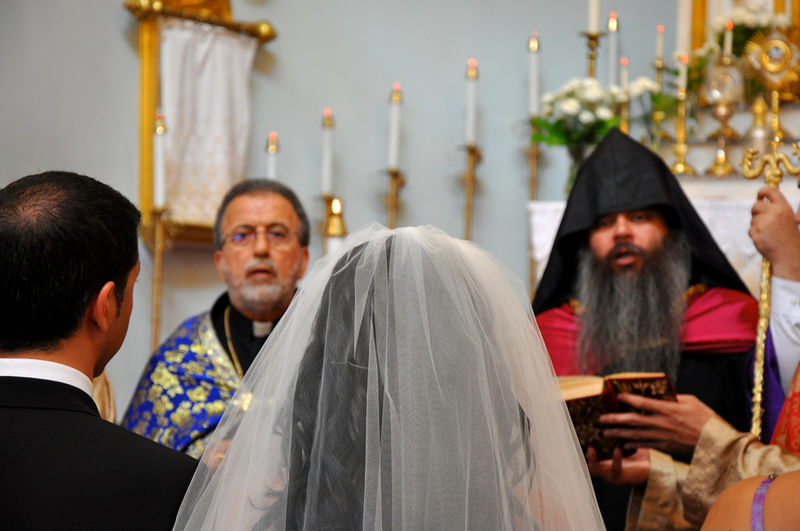Armenian Wedding
Armenian weddings blend rich traditions and rituals, starting with a traditional proposal and culminating in a symbolic Orthodox ceremony featuring the crowning of the bride and groom. Post-wedding customs include breaking plates to ward off evil spirits and festive toasts celebrating the union.
Armenian Weddings
The wedding in Aremenia includes the proposal related traditons, engagement and the wedding ceremony itself.
The proposal is organized at the meal held in the bride's home. This tradition is known as "khosk-kap".
The groom ("pessa") arrives there with some of his family members and good friends. The eldest member of his family actually performs the proposal.
The answer is given by the elders in the bride's family. After a positive answer everyone drinks some tea.
The priest is present. He blesses the couple and the engagement rings. The time and place of the wedding is set. This tradition is called "hghe ktrel".
On a day before the wedding groom's cousins tradionally prepare trays ("sinis") or baskets with various fruit, sweets and presents. One of those presens is the famous Armenian cognac.
In his home a band called "sazandar" performs traditional music. Each person there has red and green riboons tied to the clothes.
On the wedding day several members of the groom's family go to the bride's home. They dance to the traditional Armenian songs performed on the "dhol" drum and a wind instrument called "zurna". While dancing they show the things they brought on trays.
The bride's cousins join the dancers. They dance with the cookies known as "gatas" in their hands. Then they exchange these cookies for the things brought by the groom's cousins.
At the same time a bride ("hars") is in her room. Only her female cousins can see her. The woman known as qavorkin and several other women dress the bride.
In the past each of those women sewn part of the wedding dress. This tradition was known as "shordzevk".
A traditional Armenian bride wears red silk dress. On her head there is special wing-shaped decoration with feathers. When dressing a bride women sing.
The qavorkin has the veil in her hands. She walks around the bride three times and then puts it on her head.
After that the qavorkin takes a bottle of perfume and sprays little bit of it on all the single women. This is done to wish them to get married soon.
The qavorkin is involved in yet another tradition. She tries to give the bride her shoes. But the other one is missing. She starts a dance with a shoe in her hand. She offers money to whoever returns the missing shoe.
In some communties a bride's brother puts a banknote in the bride's shoe for good luck.
After all these events the bride is finally dressed up. Her face is covered. The groom is then allowed to come in, remove the veil and kiss his bride.

After series of toasts the couple is ready to go to the church wedding ceremony. But it is not so easy. A boy from the bride's family does not allow this to happen. He holds a knife and ask for some money. After paying the sum bride and groom can leave.
Most Armenians are Orthodox Christians. Each part of the religious wedding ceremony is full of symbolism. The priest first blesses the couple. Wedding rings are exchanged between the newlyweds.
In the rest of the ceremony the right hands of the couple are joined together. The ceremony reaches its peak when the bride and groom are crowned. The crowning is present in other Orthodox churches too.
During the crowning qavor is standing between the bride and groom. He is holding a cross. After that a the special cup with some wine is blessed by the priest. This act symbolically relates to the marriage at Cana of Galilee.
The bride and groom then drink from this cup. From that moment on they are united. The whole ceremony finishes by yet another blessing of the couple.
After the ceremony newlyweds go to the groom's home. A mother-in-law offers them traditional Armenian bread and honey.
At the entrance to the house there are some plates. A bride and groom step over them and break them. This act is believed to ward off the evil sprits.
There is no wedding reception without numerous toasts. In Armenia there are series of three to seven toasts one after another. Off course you are expected to drink after each toast. In most of them an expression "may you grow old on one pillow" is used.
A very important event is giving presents to the couple. Traditionaly the godfather brings the most expensive present.
The same as everywhere around the world a wedding reception include various food. In Armenia people love lamb meat. Delicacies with dried fruits and nuts are also very common.
A day after the wedding groom's female cousins bring a red apple to the bride. The apple symbolizes her virginity. This tradition is more common for Armenian villages.
Armenians believe that newlyweds should jump over the fire seven times. This should bring them good luck and ward off evil spirits.
References:
Armenian Wedding Traditions
http://arminenia.blogspot.hr/2010/02/armenian-wedding-traditions.html
Armenian Wedding and Traditions: 9 interesting points of ceremony
https://armeniagogo.com/armenian-wedding-traditions/
Armenian Wedding Traditions and Customs
http://www.beau-coup.com/armenian-wedding-traditions.htm
Armenian Wedding Traditions and Customs
https://holidappy.com/party-planning/Armenian-Wedding-Traditions-and-Customs
Armenian Traditional Wedding
http://www.wedding.am/en/wedding-traditions/armenian-traditional-wedding
Some Tips and Guides to Avoid Hazards Commonly Seen in the Armenian Weddings
http://armenianweddingtips.blogspot.com/
Anna Khachatryan, Wedding in Armenia: colorful and joyful
http://blog.wandelion.com/wedding-in-armenia/
Images
Armenian wedding ceremony (photo by Raffi Asourian, Flickr)
https://www.flickr.com/photos/zaffi/4207677748/
Armenian Wedding at Khor Virap
https://commons.wikimedia.org/wiki/File:Armenian_Wedding_at_Khor_Virap_(2).jpg